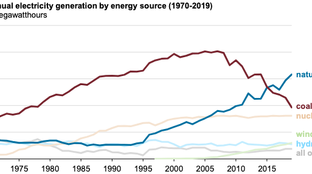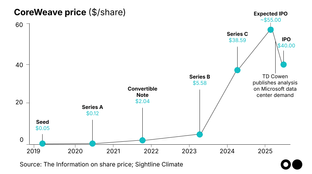
🌎 IMO sets sail for net-zero #242
The International Maritime Organization's first carbon tax ships out
[Editor's note: Since this story was first published in CTVC, Sightline's weekly climate tech newsletter, the White House announced that most reciprocal tariffs would be paused for 90 days, although a 10% baseline and 25% tariff on steel and aluminum would still apply. That pause does not apply to China, which will see an increased tariff rate of 145%.]
Happy Monday!
We’ve got the climate tech take on the tariffs in this edition — breaking down the sector-by-sector impacts of the varying imports and reciprocal tariffs already announced.
In deals, $500m for renewable energy development, $30m for energy grid software, and $30m for solar development.
In other news, big project announcements, including BECCS in Europe and lithium in the US, plus Li-Cycle’s looming bankruptcy.
And don’t miss our roundup of this Q1’s top deals, exits, and funds around the world in climate tech from last week here.
Thanks for reading!
Not a subscriber yet?
📩 Submit deals and announcements for the newsletter at [email protected].
💼 Find or share roles on our job board here.
Markets may still be waking up and reacting to Trump’s historic tariff announcement — but here at CTVC, we’re looking beyond the headlines to ask: what does a full-blown global trade war mean for climate tech? Buckle up, it’s a wild ride.
Last week, President Trump announced the most sweeping US tariff regime in over a century, slapping a baseline 10% tariff on nearly all imports and imposing "reciprocal tariffs" as high as 50% on countries with large trade surpluses or protectionist barriers (even uninhabited ones) starting this week. He also doubled down on previously announced tariffs: 25% on steel and aluminum, effective since March. Explore the math behind them here, see a full country-by-country breakdown here, and read the White House’s appendix here.
The full tariff list reads like a climate tech supply chain map — with major levies on imports from Southeast Asia, East Asia, and the EU. China was hit with a 34% tariff on top of existing duties, bringing its effective rate to 54%. The EU faces 20%. Canada and Mexico dodged the baseline tariffs (for now) under USMCA, but still face separate 25% duties on steel and aluminum, and 10% duty on energy products. Meanwhile, semiconductors, certain critical minerals, and some clean energy components were temporarily spared — though Trump has signaled sector-specific tariffs could be next.
Markets didn’t buy the logic: The move shocked global stock indices and drew swift condemnation from allies and trade partners. The S&P 500 had its worst week since March 2020 (although First Solar is up). Oil prices fell sharply (especially amid news that OPEC is boosting production). Meanwhile, the EU called it a “major blow” to the world economy, and China hit back with economic weapons beyond tariffs — both a 34% tariff on US goods and rare-earth export controls — as did Canada, with 25% retaliatory tariffs on US vehicles.
Trump officials say this is part of a broader plan to reshore manufacturing and create a “self-reliant” American economy, even as economists warn of stagflation, retaliation, and a looming global recession.
At face value, the tariff blitz is Trump’s latest salvo in a long-running effort to rewrite the rules of global trade. But an escalating trade war could be uniquely disruptive for climate tech.
The ongoing energy transition is, at its core, an industrial transition — and that means it depends on global trade. The idea of US supply chain manufacturing independence is popular in theory and a bipartisan priority, but through different means: Biden aimed to boost (clean) domestic manufacturing and critical minerals by expanding DOE’s MESC and adding domestic content bonuses to Inflation Reduction Act tax credits, while Trump is taking the trade route. But the reality of standing up supply chains is complex, capital-intensive, and slow. Tariffs may eventually spur domestic production, but in the short term they raise costs, create volatility, and stall momentum.
US tariffs x climate tech sectors
Projects with vertically integrated domestic supply chains might benefit — but even they face higher costs for components, labor, and debt financing. Meanwhile, clean energy developers and utilities are already navigating congressional uncertainty around IRA subsidies. Projects are being paused, delayed, or pulled entirely. Add tariff-driven cost spikes and fractured global sourcing, and the risk premium on new development is climbing fast.
One possible upside? If tariffs tip the global economy into a downturn, it could depress demand for fossil fuels — a backdoor boost for clean energy, though a rough one. At the same time, with the EU and UK increasingly wary of relying on US LNG after pivoting away from Russian gas post-Ukraine invasion, trade realignments could further accelerate Europe’s decarbonization push.
⚙️ Projects are caught in the crossfire. Nearly every major decarbonization technology depends on imported components now facing steep tariffs. While vertically integrated US manufacturers may have a buffer, they’re still exposed to rising costs, procurement delays, and growing geopolitical risk. China’s rare earth export controls and other countries’ retaliatory moves are already squeezing supply chains. And for long-lead projects like offshore wind or geothermal, tariff volatility upends the stable pricing, predictable inputs, and long-term signals they need to move forward.
💸 Capital is cooling just as momentum should be building. Developers and utilities were already navigating IRA uncertainty in Congress. Now, with tariff costs stacking up and global trade fracturing, the risk premium on clean energy projects is rising. Utilities in the Pacific Northwest and Northeast are petitioning regulators to defer pass-through costs on imported electricity and fuels.
🧭 Some climate innovation will move elsewhere. The IRA helped trigger a wave of climate activity in the US — but climate VC funding has fallen from 2022 highs in the US. Rising costs, policy uncertainty, and research disruptions are making other markets more attractive. China and the EU are doubling down on industrial policy, carbon border adjustment mechanisms, and green export credit support. If the US slows down, it risks losing ground in the global race for tech leadership, talent, and manufacturing capacity.
🫱 Don’t panic — but do pay attention. The energy transition doesn’t run on election cycles. In theory, if the US can weather the disruption, new capital could flow into domestic manufacturing and help rebalance supply chains. And market forces — from AI to grid demand — will keep pushing toward renewables. The ZIRP climate boom followed COVID and supply chain crises, after all. Still, this decade is critical for preventing worst-case climate scenarios, and delays carry their own kind of risk.
🏠 Gradyent, a Rotterdam, Netherlands-based digital twin energy grid platform, raised $30m in Series B funding from Blue Earth Capital, Capricorn Partners, ENERGIIQ, Eneco Ventures, Helen Ventures, and other investors.
♻️ FAIRMAT, a Paris, France-based carbon fiber composite recycler, raised $29m in Series B funding from Bpifrance, CNP, Cape Capital, Pictet Group, Singular, and other investors.
🧪 Ecoat, a Grasse, France-based bio-based paint manufacturer, raised $20m in Series A funding from European Circular Bioeconomy Fund (ECBF), Starquest Capital, and Yotta Capital Partners.
⚡ Fourier, a Palo Alto, CA-based modular hydrogen system producer, raised $19m in Series A funding from General Catalyst, Paramark Ventures, Airbus Ventures, Borusan Ventures, GSBackers, and other investors.
💧 LeakZon, a Kfar Saba, Israel-based AI-powered water management platform, raised $5m in Series A funding from Peal Holdings.
♻️ Fiberdom, a Vantaa, Finland-based sustainable wood fiber manufacturer, raised $4m in Seed funding from Heino Group, Holdix Oy Ab, and Nordic Foodtech VC.
⚡ EVident Battery, a Westford, MA-based EV battery inspection technology provider, raised $3m in Seed funding from Ibex Investors, Automotive Ventures, Avesta Fund, and Nationwide Ventures.
🌾 AdvancedAg, a Raymond, Canada-based bioagriculture input developer, raised $2m in Seed funding from Raven Indigenous Capital Partners.
🌱 Northwind Climate, a Boston, MA-based data-driven climate intelligence platform, raised $1m in Pre-Seed funding.
⚡ Silicon Ranch, a Nashville, TN-based community-focused renewable energy developer, raised $500m in PE Expansion funding from AIP Management.
⚡ Apricus Generation, a Boca Raton, FL-based solar development platform, raised $30m in Project finance funding from Atlantic Union Bank.
🔋 Energy Vault, a Lugano District, Switzerland-based grid-scale energy storage service provider, raised $28m in Project Finance funding.
🏠 Caldera, a Fareham, England-based thermal energy storage developer, raised $13m in Corporate Strategic funding from GEA Group.
🌾 Advanced Farm Technologies, a Davis, CA-based autonomous farm equipment developer, was acquired by CNH Industrial for an undisclosed amount.
Siltstone Capital, a Houston, TX-based investment firm, raised $100m for its first Clean Royalties fund to invest in energy transition projects, starting with solar energy.
Can’t get enough deals? See full listings and deal analytics on Sightline Climate.
Li-Cycle warned it may go bankrupt without fresh funding to repay debts and meet conditions for accessing its $475 million DOE loan. The company paused construction of its Rochester, New York facility last fall after costs rose, and, while Glencore has shown interest in a potential deal, no acquisition has been finalized. The situation underscores the challenges facing the battery recycling industry amid low commodity prices.
Lithium Americas and General Motors have approved the final investment decision for Phase 1 of the Thacker Pass lithium project, targeting completion by late 2027. A $250m investment from Orion Resource Partners, combined with a $2.26bn DOE loan, fully funds Phase 1 construction. The project is set to strengthen the domestic lithium supply chain.
Stockholm Exergi is moving forward with plans to build one of the world’s largest carbon capture and storage facilities, capable of removing 800,000 tons of CO2 annually. Backed by the European Innovation Fund and a 10-year contract through the EU’s Innovation Fund Auction, the project is expected to be operational by 2028. The facility marks a major step for scaling permanent carbon removal technologies in Europe. Meanwhile, Shell, Equinor, and TotalEnergies are investing $714m to expand their Northern Lights carbon storage project in Norway, following a 15-year commercial agreement with Stockholm Exergi to store 800,000 tonnes of CO2 per year.
The DOE is pushing to build data centers on federal lands, including at national lab sites, as part of its efforts to support the burgeoning AI sector. The initiative, outlined in the government's Request for Information (RFI), aims to facilitate faster deployment of critical technologies, such as nuclear, geothermal, and energy storage. This could provide an important avenue for federal support in advancing these energy technologies.
All eyes on DOE layoffs: track them on this interactive map.
Sublime Systems enters the cement fashion industry? (Gotcha… April Fools!)
Zapping seawater with electricity could charge the effort for sustainable cement.
Hitting two birds with one quark: Birds migration may rely on quantum mechanics.
Commodities traders are buying new petrol stations and power plants.
Black Rock’s Larry Fink released his annual chairman’s Letter to Investors.
Home insurance has plans to weather the storm of climate change, inflation, and regulation.
And a new report on aligning capital for energy storage in New York.
Stay current with Semafor's Net Zero newsletter, written by McDonnell, Semafor’s climate correspondent.
📅 NYC Climate Networking Meetup: RSVP to attend the 4WARD NYC Climate & Sustainability Networking Meetup on April 10th and connect with a diverse community of climate-focused individuals.
📅 Harvard x Columbia Clean Energy Conference: RSVP to attend on April 19th for discussions on the future of clean energy. The organizers are also seeking panelists for a session on financing the clean energy transition—email [email protected] if interested in speaking.
💡 Energy Storage Accelerator: Apply by April 21 to join The Clean Fight’s energy storage program, supporting high-impact battery solutions accelerating New York’s clean energy transition. Selected companies receive up to $100K in grant funding, tailored biz dev support, access to NY-BEST expertise, and connections to scaling capital.
📅 San Francisco Climate Week 2025 Events: Explore and RSVP to various events happening between April 21–27 during San Francisco Climate Week 2025, bringing together climate leaders, innovators, and advocates.
Will you be at SFCW? We’re making a tracker to help CTVC readers navigate the event. Submit your event here and we’ll publish our tracker next week.
💡 Urban Future Prize Competition: Apply to the Urban Future Prize Competition by April 28th for an opportunity to win up to $50k in non-dilutive funding as well as admission to the ACRE Incubator.
💡 IAGi Innovation Accelerator: Apply by April 30 to the IAG Innovation Accelerator, which partners with startups to address key challenges in the aviation industry. The program offers two tracks: Deploy (12-week proof-of-value) and Discover (24-week deep tech exploration).
💡 Women Entrepreneurs Boot Camp (WEB) 2025: Apply by May 12th to join Project W's WEB 2025 on June 24, a program dedicated to elevating women entrepreneurs in climate tech offering workshops, mentorship, and networking opportunities.
Senior Account Executive, Senior ML Software Engineer, Research Associate - Grid, Senior SWE, Research Associate - Generalist, Summer Research Intern @Sightline Climate
Data Engineer @Cleanview
Software Engineer @Arch
Founding SWE @Jane Energy
Product Manager @Verse
Strategic Finance Manager @Lunar Energy
Clean Transportation Fellow, Senior Program Manager @Massachusetts Clean Energy Center
Technical Program Manager, Clean Energy Instruments @Google
Project Manager, Process Engineer @MGA Thermal
Energy Markets Analyst @Bright Power
📩 Feel free to send us deals, announcements, or anything else at [email protected]. Have a great week ahead!

The International Maritime Organization's first carbon tax ships out

Trump’s coal push ignores economic reality and attractive alternatives

The AI company’s debut shows where the chips are falling